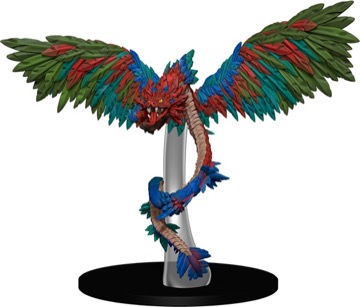Nature's Protectors
Monday, February 12, 2018
We're now a full month into our journey through the Jungle of Despair, the next set of Pathfinder Battles miniatures from WizKids, and this week I get to show off some of my favorite figures in the set. So without further ado, let's begin!
As long as humanity has stood on the edge of the jungle and peered into the darkness beneath the impenetrable canopy, the imagination has created as many phantasmal dangers as actually exist in the unforgiving environment. But not all of these dangers are primeval, unthinking beasts that see explorers as little more than a potential meal. Many, in nearly every culture and mythology, exist to protect the untamed, untainted regions of the world from humanity's encroaching influence.
The first such creature in Jungle of Despair is the couatl, a lawful good staple of fantasy roleplaying games that takes its inspiration from the Aztec god, Quetzlcoatl, who is often referred to as "The Plumed Serpent." As such, the couatl is a mighty, mystical flying serpent with wings the color of a jungle bird's plumage. Couatls make for great protectors of jungle ruins or sacred sites for their ability to aid the adventurers, but only if the interlopers can convince the winged serpent of their true intentions and veneration for the purity of the unaltered wilderness. The couatl is a Large uncommon figure.
Similarly, nature spirits from the First World, the capricious realm of the fey, often serve as protectors of portions of the Material Plane. Comprised in large part of dense undergrowth and ancient trees, jungles make for the perfect habitat for dryads, each of whom is linked to a specific tree and given dominion over a particular copse or grove. The dryad in Jungle of Despair is a re-posed version of the reclining dryad illustration from the Pathfinder RPG Bestiary, and thus can be used in nearly any wooded environment, from a palm tree in a desert oasis to a lone evergreen high atop a mountain vista. The dryad is a common Medium figure.
Often filling a niche similar to that of a dryad but found in other environments beyond the woods is the enigmatic nymph, a paragon of natural beauty who uses her charms to bend would-be defilers of the wild to her will. Also based on the primary creature illustration from the Pathfinder RPG Bestiary, the nymph has been given some clothes in her miniature iteration, in the form of a seaweed skirt. With a pair of starfish stuck to her legs, she makes a great protector of seaside grottoes or isolated beaches but can still easily fit in anywhere that nature needs a steward. The nymph is a Medium common figure.
Mortal protectors of the natural world are no less powerful and intrinsically tied to the land, as in the case of the elf druid, a Medium common figure perfect for either a player character or in a cabal of Green Faith worshipers. In fact, the illustration used as reference for this figure was the Green Faith druid in Pathfinder Player Companion: Faiths of Balance; now where could his hawk animal companion have gotten off to?
Finally, we have a guardian not born or spawned by the raw power of nature itself, but rather created with arcane magic and set to a specific, ceaseless task by its master: the clay golem. As a construct, this Large uncommon figure has no natural habitat, and thus can serve campaigns set in ancient jungle ruins, high-magic metropolises, and everything in between. While a clay golem can take any shape its creator molds it into, the iconic Pathfinder clay golem (and thus the miniature) has a hulking humanoid form and the head of a jackal, giving it a decidedly Egyptian feel, making it equally appropriate for use in the moldering pharaonic tombs of the Osirian desert.
That's it for this exciting installment of Jungle of Despair! Be sure to tune in next week for a look at some of the player character-appropriate figures in the set. Until then, roll high, Pathfinders!
Mark Moreland
Franchise Manager
We have updated our Privacy Policy.
Paizo.com uses cookies. You can block paizo.com from using cookies within your browser settings, but doing so will hinder site functionality.
More information can be found in our Privacy Policy.





